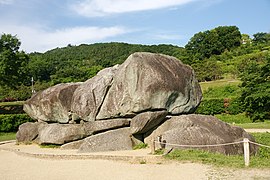Ishibutai kofun
Ishibutai-Kofun ( Japanese 石 舞台 古墳 ), also Ishibutoya- or Ishifutoya-Kofun ( 石 太 屋 古墳 ), is a tumulus ( Kofun ) and thus an archaeological site from the late Kofun period (7th century) in the "National Historical Park Asuka ”in Asuka Township , Nara Prefecture . It is believed that this kofun is the tomb of Soga no Umako . It is the largest megalithic structure in Japan. It was declared a Special Historic Site in 1952 . It is on the tentative list for UNESCO World Heritage .
overview
The first excavations at Ishibutai-Kofun by Hamada Kōsaku from Kyoto University took place in 1933 and 1936. In 1954 and in 1959 restoration work took place.
The grave site was originally covered with earth, which over time eroded and was removed. The exposed stone chamber consists of approx. 30 megaliths with a total weight of 2300 t. The capstone alone weighs around 75 to 77 t. The outside of the tomb is square with a side length of 80 to 90 m.
The grave chamber, which is accessible through two side passages ( 横 穴 式 石室 yokoana sekishitsu ) made of granite, is 7.7 m with a ceiling height of 4.7 m and a width of 3.5 m. The side corridor ( 羨 道endō ) is eleven meters long and 2.5 meters wide. It is not entirely clear whether the Ishibutai kofun has a rectangular floor plan. It could also be a tomb with a square floor plan and a round tumulus ( 上 円 下方 墳jōenka hōfun ) or a tomb with an octagonal base ( 下方 八角 墳kahō hakkakufun ).
The burial chamber has a drainage device, as the upper reaches of the Fuyuno River flows by near the facility. The coffin was destroyed by robbery excavations.
Burial and person buried
A first mention of the barrow with the name Ishibutoya-Kofun as the tomb of Temmu -Tennō can be found in the work "Washū kyūseki yūkō" ( 和州 旧 跡 幽 考 , 1681) by Hayashi Sōho. There is also a description of Ishibutai-Kofun in Sugagasa no Nikki ( 管 笠 日記 ) Motoori Norinaga from 1772 . Norinaga assigns the Ishibutai-Kofun and the Miyakozuka-Kofun to the south of it to the two Tennō Suiko and Yōmei .
The author of the Unohara Nikki ( 卯 花 日記 ) from 1829, however, assumes that the Ishibutai kofun is not the tomb of Soga no Umako. In 1848 the Ishibutai-Kofun appeared in the work "Collection of Famous Places of the Thirty-Three Holy Places of Kannon Worship in Western Japan" ( 西 国 三十 三 所 名 所 図 会 Saigoku sanjūsansho meisho zue ) by Edo-period woodcut artist Akatsuki Kanenari (1793–1861). There the height of the kofun is given as around two ken (3.6 m) and a circumference of 10 ken (approx. 18 m). Akatsuki also suspects that it is the tomb of Temmu -Tennō.
In addition to the theory that it is the tomb of Soga no Umako, there are also archaeologists such as Mizuno Masayoshi (1934–2015) from the University of Nara who assume that Soga no Iname , Umako's father, is buried here.
Artifacts
During the excavations in the outer area of the Kofun, Haji and Sue ceramics , metal fittings made of bronze and coins from the Song period and Kan'ei coins from the Edo period were found.
gallery
Web links
Individual evidence
- ↑ a b Ishibutai Kofun Tumulus. In: Asuka-Fujiwara Archaeological sites of Japan's Ancient Capitals and Related Properties. Retrieved November 12, 2019 .
- ↑ Ishibutai Tumulus. Asuka Historical National Government Park, accessed November 12, 2019 .
- ↑ a b Yasuhito Kakiya: 馬 子 の 墓 . Asuka Historical Museum, 1995, accessed November 12, 2019 (Japanese, With numerous illustrations).
- ↑ 石 舞台 古墳 . Nanto Bank, accessed November 12, 2019 (Japanese).
- ↑ a b c d 石 舞台 古墳 . Asuka Historical National Government Park, accessed November 12, 2019 (Japanese).
Coordinates: 34 ° 28 ′ 0.4 ″ N , 135 ° 49 ′ 34.1 ″ E







